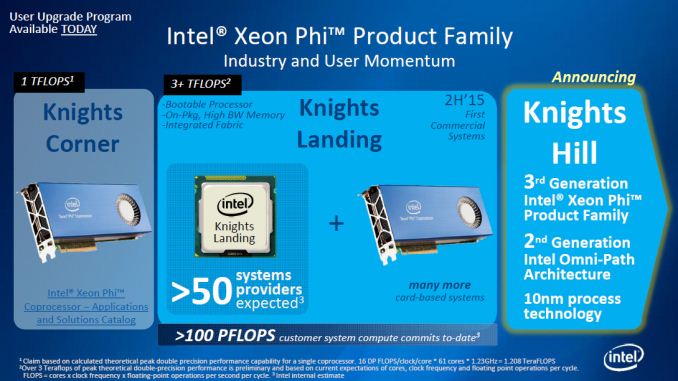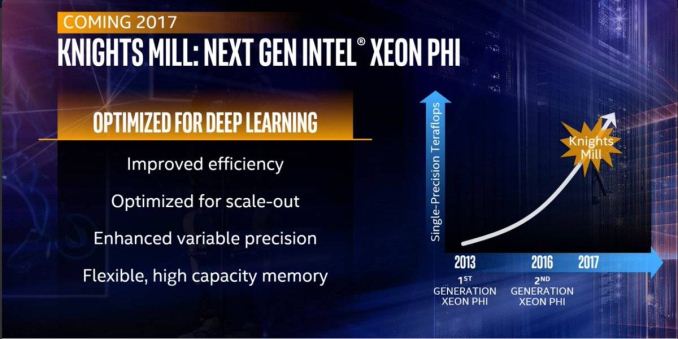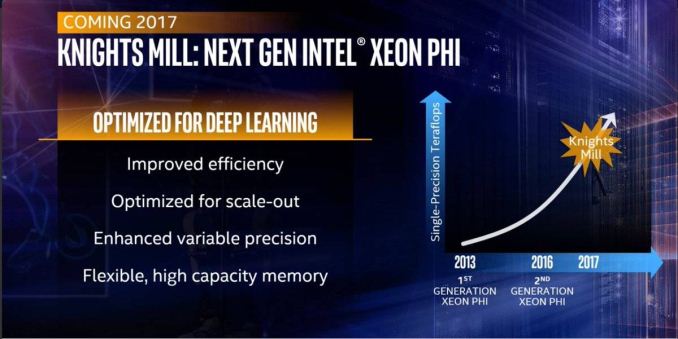Intel Announces Knights Mill: A Xeon Phi For Deep Learning
In a brief announcement as part of today’s Day 2 ketnote for IDF 2016, Intel has announced a new member of the Xeon Phi family. The new part, currently under the codename of Knights Mill, is being aimed at the deep learning market and is scheduled for release in 2017.
At this point there are more unknowns than knowns about Knights Mill, in part because Intel has not offered much detail on how it fits into the larger Xeon Phi brand. The company had previously announced in 2014 that the successor to the current Knights Landing design would be Knights Hill, a true 3rd gen Xeon Phi built on Intel’s 10nm process. However this week there has been no mention of Knights Hill, whether Knights Mill is Knights Hill renamed, or what the manufacturing process Knights Mill is being made on. With that said, as Knights Mill is scheduled for 2017, it’s unlikely that it’s Knights Hill (at least as initially planned), as 2017 would be too early for a very large 10nm chip from Intel’s fabs.

Announced In 2014 And Currently MIA: Knights Hill
Working on the assumption at the moment that Knights Mill is in fact its own part, what we do know is that with it, Intel is making a very clear play for the rapidly growing machine learning market, and indeed this will be its defining characteristic. Among the features/design tweaks for the new processor, Intel is adding what they are calling “variable precision” support. What that fully entails isn’t clear, but the use of lower precision modes has been a major factor in the development and subsequent high performance of machine learning-focused processors, so it’s likely that this means that Intel is adding FP16 and possibly other lower-precision modes, something the current Knights Landing lacks. As machine learning typically does not require high precision, these lower precision modes potentially allow for a major increase in processor throughput, as more, narrower operations can be packed into a SIMD.
Also on the feature list is improved scale-out performance. It’s not clear right now if this is some kind of fabric/interconnect change, or if Intel has something else in mind. But the ultimate goal is to make clusters of Xeon Phi processors perform better, which is an important factor in bringing down the training time of very large and complex datasets. Meanwhile there are also unspecified memory changes for Knights Mill, with Intel touting the chip’s “flexible, high capacity memory.”
Competitively, this is a shot across the bow at NVIDIA’s own Tesla products, and in their comments here at IDF and in previous presentations, Intel has not shied away from comparing their tech to GPUs and touting why they believe Xeon Phi to be superior. One such example, though briefly mentioned, is that like Knights Landing, Knights Mill is capable of acting as a host processor. So expect to see Intel promoting the benefits of not needing separate host processors & co-processors, and how Knights Mill can be attached directly to system RAM. This, along with the performance differences between the GPU architectures and Knights Mill, will undoubtedly be a recurring fight between the two companies both now and next year when the new processor actually launches.
In the meantime, we’ll keep digging for more information on Knights Mill, and hopefully get a better idea of how it fits into the Xeon Phi family.
(Image Courtesy The Register)


